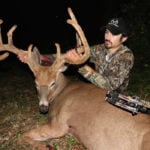Gobble after gobble resonates from the timber below. Not one volley of yelps, clucks or purrs go unanswered. Then, silence. Every string of calls come up empty. That sinking feeling takes hold in the pit of your stomach. Red-hot gobblers go cold all of the time. It’s a common occurrence. The question is, why? Well, there is no concrete answer. It just depends. But here are some of the most common reasons.
Toms don’t always rip your ears off with gobbles. But when they don’t, there’s usually a reason why. You just need to know which one.
1. Hens Intercepted Him
Nasty, filthy, adulterous hens are often the reason gobblers close their mouths to your calling. He might be alone on the roost. He might still be alone after he flies from the roost. But here’s the kicker. Studies (and general observations for that matter) show that hens go to gobblers more often than gobblers go to hens. It’s not uncommon for the ladies to home in on your gobbler and intercept him before he gets to you.
The Fix: Mock the boss hen. She’ll often come looking for a fight. Big boy, tongue hanging out, won’t be far behind.
The ladies can pose a big problem. Hens often go to gobblers that get fired up from your calling.
2. He Got Whipped
Birds get in a tussle from time to time. This especially happens during the early season. It’s a major reason gobblers quit gobbling. Whether it’s another tom, or a gang of jakes, it can ruin a hunt.
The Fix: There isn’t a lot you can do. The main thing is to remember he isn’t going to be as bold now. Strutter decoys, jake decoys, gobble tubes and other aggressive tactics won’t be as useful now. Stay reserved in your tactical approach if you continue to pursue this bird.
A group of jerk jakes can ruin a good spot. Several jakes will whip a tom any day of the week.
3. You Called too Much
Overcalling is a huge problem in the spring turkey woods. Hunters yelp, yelp and yelp some more. They cutt, cluck and purr like their life depends on it. Sometimes this can work. Most times it doesn’t. It’s all about reading the gobbler. I wouldn’t recommend it on public land; but if he answers every time and is coming in hot, go for it. But if he isn’t very responsive, better back off.
The Fix: Come back tomorrow and use soft calling to lure him in. Throw in some scratching and wing beats. Just don’t tear his ear off with yelps. Hens don’t constantly jack their jaw. You, as the caller, shouldn’t either.
4. You Called too Loud
Overcalling isn’t the only problem. So is calling to loudly. Hens get loud when they’re excited, alarmed or trying to locate distant birds. They don’t generally get very loud when communicating with nearby birds. Adjust your calling. Get loud when birds are far. Gear it down as they close the distance.
The Fix: Listen to real hens. That’s what you’re after anyway. Mimic their vocal behaviors and patterns. You’ll kill more turkeys that way.
5. The Thermometer
Toms are fickle creatures. They can be hot-to-trot one minute and ice cold the next. One reason birds seemingly disappear is because of temperature. Toms don’t gobble excessively during the middle hours of the day. If you find one that does, get ready, he wants to take a ride in the bed of your truck.
The Fix: Dominant, and sometimes sub-dominant, toms go to strut zones during the middle hours of the day. These are cool, shaded areas where they can post up and strut. If you know of a probable strut zone, get there before he does.
Here the author poses with a gobbler that only gobbled one time. He had a hen when the author killed him.
6. He Smelled a Rat
People get picked out all the time. Whether it’s you or farmer Brown, turkeys are going to see people. Sometimes they barely spook. Sometimes they run to the next county. Regardless, the hunt is generally over.
The Fix: Birds stay on edge longer when they see humans in comparison to other predators. You’re best shot is to call it quits for the day or to try another bird. If you’re stuck on this turkey, make a very wide circle and head him off. Don’t be aggressive though. And keep calling and the decoying to a minimal.
7. Predators Intervened
Coyotes and bobcats can spoil a good hunt. They can silence a tom on sight. But just because a sly dog or slinking cat enters the picture doesn’t mean the hunt is over.
The Fix: Don’t move. Give the bird time to relax. Most times, predators won’t make major alterations to a turkey’s route unless there is a direct confrontation between the two. If that happens, go find another bird to court.
8. He’s Closing In
Just because he quits talking doesn’t mean something went afoul. Sometimes, it means everything is playing out just right. Gobblers often go silent because they’re coming in. This happens more times than hunters realize. Most people get worried and impatient the moment he doesn’t respond. This is a mistake. Give it at least twenty to thirty minutes after a bird has went silent. Sometimes it takes that long, or longer, for him to work within range.
The Fix: Shut up, sit still and pull the trigger.
Conclusion
Gobblers don’t always gobble the whole way in. Sometimes they don’t come in at all. But then, sometimes they come in dead silent. Every hunt is different. Just don’t be surprised if a gobbler goes silent on you this spring. It’s going to happen.

 By
By 



